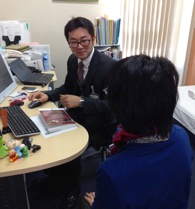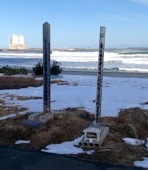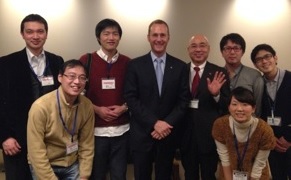From the President: The Japan tsunami – three years on.

Young family doctor, Dr Hiroshi Takayanagi,
at the Kitakata Centre for Family Medicine in Fukushima Prefecture in Japan
español
What happens next? The role of family doctors in supporting their communities following a disaster
We all remember the tragedy of the March 2011 tsunami that hit the Pacific coastline of Japan following an earthquake, killing thousands of people and destroying coastal towns and villages. And the global fears that followed when the damaged Fukushima nuclear power plant exploded releasing radiation into the atmosphere. The radioactive contamination resulted in over 100,000 people being evacuated from their homes and a 50 kilometre exclusion zone was established around the damaged nuclear plant and the path of the radiation fallout.
Last month I was invited to visit communities in the Fukushima region of Japan affected by the tsunami and the nuclear reactor disaster. I was keen to learn about the role local family doctors and their teams are continuing to play in assisting in the recovery of the surviving members of the devastated communities. It was a sobering week.
Three years later, the evidence of the damage caused on that terrible day remains. Many people still live in temporary housing and are prohibited from returning to their abandoned homes. Many people, especially young families, have moved away to other parts of Japan. Many elderly people left behind grieve for their missing families, their lost homes and their lost way of life. 200,000 affected people are being followed up regularly in special clinics set up to screen for problems related to radiation exposure.
Photo: Empty coastline with a reconstructed graveyard as the sole
reminder that a village community once thrived in this location before
the 2011 tsunami

The coastline is stark, having been cleared of the ruins and debris that was all that remained of coastal cities and rural communities and the surrounding forests destroyed by the tsunami. The villages have gone, the farms have gone, the forests have gone. It is like there has never been anything there. The exception is the exclusion zone around the nuclear reactor where the damage from the tsunami is still visible with damaged buildings, upturned cars and fallen trees. Whole villages that survived the tsunami but were subjected to radioactive fall out are now ghost towns with deserted homes and shops with empty windows and no sign of life. Parts of the exclusion zone are being deemed less dangerous now and have been opened for people to visit during the day but not return to live.

While in Fukushima Prefecture I visited the damaged towns of Soma and Minami-soma, a number of family medicine community clinics and a community support centre for residents in temporary accommodation.
This visit was a stark reminder of the challenges people face in rebuilding their lives and their communities following catastrophic events. And the huge impact such events have on the physical and mental health of each affected person.
Photo: Makeshift memorials to loved ones lost during the 2011 tsunami, on the Pacific Coast at Minami-soma in Japan
The people of these communities have been supporting each other as they come to terms with the dramatic changes in their lives. Community health programs are assisting people still living in temporary shelter accommodation. Activity programs bring people together and foster a continuing sense of community. The family doctors of this region have been a core part of this work.

I was in Japan as the guest of the Government of the Fukushima Prefecture. My visit was organized by Professor Ryuki Kassai, Professor of Family Medicine at the Fukushima Medical University.
Photo:WONCA president with Professor Ryuki Kassai and young family doctors attending the Winter Education Seminar of the Japan Primary Care Association, February 2014
Ryuki is a well-known and respected member of WONCA. His series of reports for the British Medical Journal in the aftermath of the disasters provided an extraordinary insight into the impact on individuals, families and communities, and the roles that family doctors and the members of our teams can play in supporting our communities during and after such devastating events.
http://blogs.bmj.com/bmj/2011/03/21/ryuki-kassai-from-fukushima-the-first-seven-days-of-the-disaster
Ryuki and I also discussed the wider challenges of provision of support for the very old in Japanese society. Japan, like many nations, is examining how to best care for the increasing number of elderly people in their community, realising that continuing to place very large numbers of people in nursing homes or hospitals is not a feasible option, and looking at the increased role primary care services can play in supporting keeping people in their own homes or living with family members. There is also awareness that, while many people in Japan may be living to a great age, for many the quality of life in their last years, sometime decades, is not good due to problems related to the impact of co-morbid chronic disease, infirmity, sensory loss and dementia. And there are concerns about inappropriate investigations and procedures being carried out by doctors on very old people at the end of their lives. There is also the challenge of providing care to people at the end of their lives, and especially home-based palliative care, something that is a core part of our work as family doctors in many countries. Just as we specialise in the provision of ”first contact care”, family doctors also specialise in the provision of “last contact care” for many of our patients.
In Japan I learned that many very old people, even those with advanced dementia, can still have a sense of purpose as valued members of the community. They may be responsible for keeping part of the street outside their home swept or clear of debris. Or being part of after school programs caring for children. Or caring for small garden plots which enhance the beauty of their local area. For many of the elderly survivors of the tsunami and those relocated from villages affected by the radiation fallout and now living in temporary accommodation, this sense of purpose has been lost and many people are depressed and withdrawn and have become housebound. This is compounded because many of the young families with children in the radiation affected areas have left and do not return to visit their aged parents and grandparents because of fear of exposing the children to radiation. The local family doctors tell me that, for many elderly survivors, the impact of lifestyle risks may be worse than the radiation risks, due to increased alcohol use, poor diet and obesity, and related mental health problems and risk of self-harm and suicide.
I was privileged to meet with many young family doctors working across the Fukushima Prefecture with Ryuki. I also had the opportunity to meet with a large number of young family doctors taking part in the Winter Education Seminar in Tokyo of the Japan Primary Care Association, the WONCA member organization in Japan. I was inspired by the enthusiasm of the young family doctors of Japan who are working together to tackle the many health care issues facing their local communities and their nation.
Michael Kidd
WONCA President